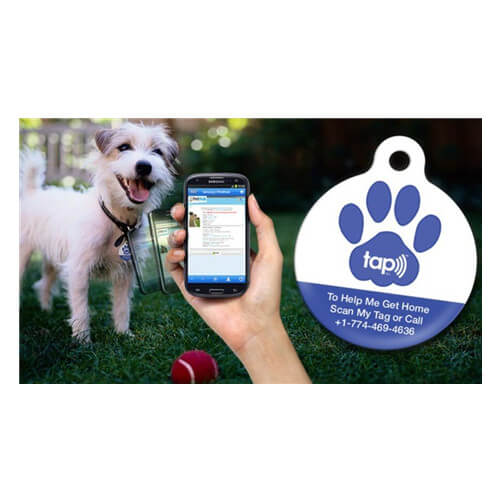RFID Tracking and Identification for Animals
There have been numerous outbreaks of animal epidemics all over the world in recent years, including mad cow disease, foot-and-mouth disease, and bird flu, all of which have harmed people's health and well-being. As a result, it is highly valued in countries all over the world. This is especially evident in Europe and Latin America. One of the most important of these measures has emerged as the use of RFID tags to identify and track animals. To accomplish this, governments have moved quickly to enact legislation and implement a variety of methods to improve animal management.
The British government requires animal tracking and identification for cattle, pigs, sheep, and goats, as well as horses and other animals. RFID technology has been discovered to be a fantastic solution to this problem, as well as the key to realizing the intelligence and information required for animal management operations.
RFID Technology's Benefits for Animal Tracking and Identification
Using an RFID animal identification and tracking system, it is possible to identify and track all types of animals, which can be used to improve the control and supervision of exotic animal diseases, protect the safety of native species, ensure the safety of international trade in animal products, improve the ability to diagnose and report animal diseases, and respond to animal epidemics both at home and abroad. RFID animal identification and tracking systems are becoming increasingly popular due to their ability to identify and track a wide range of animals.
RFID animal ear tags, as well as RFID animal ear readers, have been seen in breeding facilities. Cattle on modern farms are implanted with RFID ear tags from birth. RFID technology is becoming more common in farms, and it is gradually being expanded to include things like a weighing table and milking table, as well as things like access control and automatic feeding stations, as well as animal tracking management, bringing a whole new level of experience to livestock farms.
RFID Animal Identification and Tracking Systems Have a Variety of Applications
RFID tags encased in small glass bottles were used for the first time to certify the identity of racehorses. RFID animal identification provides a set of practical strategies for pasture management in the twenty-first century. Using an RFID system, you can keep an exact and complete record of animal feeding, growth, and illness prevention. Furthermore, it is capable of correctly identifying meat quality and other information, allowing for the traceable management of animals and animal products from feeding to sale. Additionally, it is an excellent solution for pet administration.
Animal Husbandry Management
Animal Husbandry Management is a broad term that refers to all aspects of animal management.
RFID tags and readers are well suited for use in harsh environments, such as animal husbandry and the transportation of agricultural and ancillary products, due to their excellent anti-interference performance and long service life.
RFID technology is most commonly used in animal husbandry in the field of automatic identification, such as data gathering and material tracking in animal husbandry, where it has the most potential. It is capable of realizing a wide range of safety management problems in the animal husbandry management process, from production to final consumption, such as information input, information transmission, logistics tracking, information query, and so on.
Production tracking
The first step in incorporating RFID technology into livestock production and breeding is to implant RFID tags on animals, which serve as a permanent digital file and unique identification attribute for each animal throughout the production and breeding process. Livestock owners can use an RFID tag to enter basic information about their animals into a chip, such as the animal's characteristics and immunity, the type of vaccine used, the manufacturer and batch number of the vaccine's production, the vaccination method, the vaccination dose, and the amount of immunity the animal has, among other things. An animal owner only needs a handheld data collector to obtain livestock-related information.
Distribution tracking
RFID technology can be used throughout the animal husbandry and food production processes, allowing the establishment of a traceability system for the entire food supply chain, from farm to fork. RFID technology can be used to verify the health of dairy cows during the slaughter of animals and poultry. The slaughterhouse's back-end management system is integrated, and the necessary information is then entered into the meat supervision platform.
Furthermore, the RFID animal tracking system can track the entire transportation process, locate and monitor the transport status of products in real time, and provide information on activities such as disinfection, inspection, and quarantine, as well as transportation, to determine whether or not the animals meet the factory's specifications.
Consumption tracking
RFID technology has the potential to increase logistics efficiency in the consumption of animal husbandry goods. Consumers can learn more about a product's origins, manufacturer information, ex-factory date, shelf life, and whether it has received safety certification from the appropriate departments, among other things, by attaching RFID tags to it. It is also responsible for the supervision and encouragement of animal husbandry producers and processors, with the goal of ensuring food safety and the overall interests of consumers.
Pet Management and Care
Currently, several countries and regions, including the United States, Canada, Australia, and China, have implemented RFID electronic logo management for pets. This type of radio frequency identification technology (RFID) can help us track down and assess the situation of our pets at any time.
Pet identification
Because of the chip's long lifespan of more than 20 years, each pet implanted with a chip is assigned a globally unique identification number (UID), which serves as the pet's electronic identification card for the rest of its life. The pet chip can also save basic information about pets, such as the pet's name, type, gender, date of birth, physiological parameters, and the owner's information, such as address and phone number.
By scanning the RFID animal tag on the pet's collar, pet regulators or pet hospitals can quickly and easily obtain pet information. The RFID animal identification system can also query the pet's UID number, and you can access the pet database via the Internet to obtain more and more detailed information about the pet.
Quarantine Information Inquiry
Pet chips and databases, like basic information about pets, will save the type of pet and the date and time of vaccinations. Because of permission settings in the program, only pet supervision departments and epidemic prevention departments have access to the history of pets who have received immunizations via handheld readers or management software. The system can also be used by pet supervision departments for the general public to manage pet transfers (transfers of ownership), enter new pet information, and keep track of annual inspection records.
Pet tracking and querying
Because an RFID pet chip is embedded in the stray dog, the staff of the stray pet shelter can instantly obtain information about the pet's owner and notify the owner to either pick up their pet or have it returned to the owner's house when they see the stray dog. Owners of lost pets can log into the RFID system for Internet query and management, as well as to post their pets' information and use the network to find their pets faster if they have logged in with their lost pets' information.
Obtaining and Disseminating Data
Because of the openness of its user data region, which is accessible to anyone who owns reading equipment that is compatible with the pet chip protocol, it is possible to read and extract open information from a pet chip. Pet information can be easily shared between pet monitoring departments, epidemic prevention departments, animal hospitals, animal shops, and individual pet owners, making pet management tasks like immunization and feeding extremely convenient. When the pet's owner is transferred, the pet chip can accept repeated read-write, overwrite, delete, and other operations, allowing information about the pet's new owner to be entered into the chip quickly and safely.
RFID Animal Tags That Are Frequently Used
RFID animal electronic tags can store a variety of animal data and have a unique 64-bit (8-byte) identification code that adheres strictly to the ISO standard, making them the only ones of their kind in the world. RFID tags are widely used in animal management to track and identify various animal things. RFID tags are typically designed and packaged as various types of animal objects. Animal RFID tags are classified in a variety of ways, including neck collar type, ear tag type, injection type, and pill type electronic tags.
The RFID chip is housed within a cylindrical acid-resistant container in the pill electronic tag. A container is passed through the animal's esophagus and into the ruminant's stomach juice to accomplish this. The two most important characteristics of this strategy are its simplicity and dependability. Furthermore, the electronic tag can be implanted in the animal without harming it.
ConclusionThe combination of RFID technology, with RFID tags serving as the carrier and modern computer network technology serving as a means of communication, simplifies animal husbandry administration. Through identification coding, logo wearing, identity identification, information input and transmission, data analysis and query, this system can implement integrated monitoring of livestock from birth to slaughter and consumption, allowing for the achievement of animal husbandry intelligence as well as an improvement in the level of animal husbandry management at each stage. As a result, the use of RFID technology in animal husbandry administration has a promising future.

RFID Animal Ear Tags
It is worn on the animal's ear and outperforms a barcode ear tag in terms of performance. RFID ear tags for animals are becoming increasingly popular. It adheres to the international standard ISO11784/5 FDX-B and can store far more data than a barcode. It is long-lasting and can withstand harsh environmental conditions such as oil pollution and rains, making it ideal for the administration of livestock raising and butchering operations.

Implanted RFID Animal Microchip
RFID Animal Microchip Injection with Implanted RFID Electronic Tags has grown in popularity in recent years, with the basic premise being that they are implanted under the skin of animals using syringes, establishing a permanent connection between the animal's body and the electronic tags. Cats, dogs, horses, pigs, cows, lambs, rabbits, donkeys, foxes, and other small animals can all benefit from the injectable tags, which can be as small as a grain of rice.

RFID pigeon tag
RFID Pigeon Foot Ring is possible to track poultry or birds such as chickens, pigeons, ducks, geese, and other small birds using an RFID pigeon tag, also known as an RFID bird ring. This tag is typically attached to leg bands and is difficult to remove, allowing poultry or birds to be tracked more effectively. The RFID pigeon foot ring is frequently equipped with a 125 kHz or 13.56MHz RFID chip and is available in a variety of colors and sizes to meet the needs of various target species.

RFID epoxy tag for animals
RFID Epoxy Tag for Pets, which typically operate at a frequency of 125 kHz, are commonly used in pet identification and tracking. It is made of an environmentally friendly epoxy, is spherical and smooth, and is completely safe for pets. It's also small and delicate, and it's easy to use and care for. Epoxy tags come in a variety of colors, styles, and chips, and you can even personalize them by uploading a photo of your pet to make them truly one-of-a-kind.

electronic collar tags
electronic collar tags are frequently used for animal tracking and management. The collar electronic tag is easily transferable from one animal to another, making it ideal for automatic feed rationing in the stable and milk production measurement.

RFID Pill tag
The RFID chip is encapsulated in an acid-resistant cylindrical container by the pill electronic tag. The container is then inserted into the ruminant's forestomach juice via the animal's esophagus. The most important characteristics of this approach are its simplicity and dependability. And the electronic tag can be placed in the animal without harming the animal.
Request A Quote or Samples

